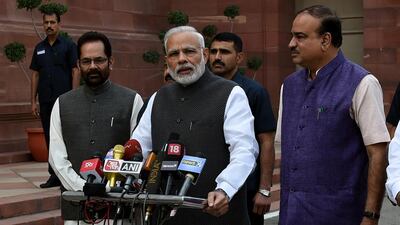The joke doing the rounds a few weeks after Indian prime minister Narendra Modi’s surprise ban on high-value currency notes is that people haven’t been protesting on the streets because they’re so busy standing in line at the banks to withdraw cash.
As with most good jokes, there is probably a grain of truth in that one. More importantly though, it highlights a noteworthy aspect of the Indian public’s response to Mr Modi’s audacious demonetisation strategy, which knocked out 86 per cent of the country’s cash supply overnight. There has been much muttering, some downright raucousness, many hard-luck stories and woeful accounts of people unable to pay for cremations and hospital admissions, small businesses unable to ply their trade, day labourers and their families starving because no one has small currency notes with which to pay them. But, there has been no significant public disorder. Even the full-on protest by 10 opposition parties – an Aaakrosh Diwas or day of anger was organised on November 28 – whipped up less frenzy than might have been expected, given the privations and frustrations endured by millions since November 8.
News reports from Delhi, Mumbai and other Indian cities have consistently said that most of the people forced to queue for hours to deposit the now-illegal 500- and 1,000-rupee notes and exchange them for new ones, or to simply withdraw cash for the business of daily life, are remarkably supportive of the government’s intentions. They express the hope that unaccounted cash, which Indians call black money, will become worthless. The hope is that India’s parallel economy, which makes up as much as a fifth of its GDP, will be crippled. Most of those abnormally patient queues fiercely hope and believe that the temporary personal inconvenience will have been worth it in the end and that the culture of entrenched corruption will have been substantially addressed.
That is all well and good. Hope is important for the task of nation-building. It was once said that howsoever much a people accepts finite disappointment, it must never lose infinite hope. However, Mr Modi cannot presume on the people’s patience for too long. Much will depend on how quickly and efficiently his government can inject lots more cash into the market.
So far, this has been a painfully slow and patchy exercise prompting the criticism that Mr Modi chose a high drama, politically-shrewd economic shock-and-awe strategy with an eye on important state elections in Punjab and Uttar Pradesh early next year, rather than a meticulous, well-considered plan.
For instance, some of the new currency meant to replace the now worthless 500-rupee note has been found to have printing errors. Not only does this cause confusion, it can perilously affect public confidence in the government’s financial instruments. New notes are also the wrong size for ATMs, which means people will have to wait for the changeover. And for all that on Sunday Mr Modi, outlined a grand vision of a massive shift to a “less-cash society” with the final goal of a cashless economy, the reality is that India overwhelmingly deals in paper money.
Roughly 90 per cent of all transactions in India are done with cash, a high proportion compared to advanced countries such as the US. Harvard professor Kenneth Rogoff, who was formerly chief economist of the International Monetary Fund, recently said that cash accounted for just 10 per cent of the value of all transactions in the United States. More to the point, a substantial proportion of Indians don't have a bank account – Mr Rogoff estimates it at nearly 90 per cent, compared to just eight per cent in the United States.
Finally, as a Reserve Bank of India report acknowledged in March, the country’s infrastructure for cashless transactions – by debit card and mobile payment – is poor. It said that at 6.7 average card transactions per person, Indians are at the lowest end of the cashless-payment spectrum. In Australia, it is 249.3; in Canada, 247.9; in the UK, 201.7; Brazil, 54.8; China, 14.4.
The point is that the sheer unpredictability of Mr Modi’s move could go either way. Unpredictability in a country’s behaviour and that of its leader is an admirable strategic advantage, if we go by the praise lavished on this characteristic by US president-elect Donald Trump on the campaign trail. According to Kalpesh Mehta, who represents Mr Trump’s brand and business interests in India, and met the billionaire in New York after his election win, “his kids knew about it [Mr Modi’s demonetisation]” and they called it an “incredibly bold move”.
It is fair to say that surprise is an important element in rendering unaccounted cash reserves unusable. But it can have enormous consequences if demonetisation is not properly managed, as happened with the former Soviet Union. Back in 1991, Mikhail Gorbachev declared 50-ruble and 100-ruble notes invalid as of midnight January 22. Old currency could be exchanged for new over a 72-hour period.
Some historians and commentators say the consequences of the resulting economic dislocation were severe, causing a massive loss of faith in the Soviet government’s financial instruments and eventually leading to the break-up of the USSR. After another total demonetisation in 1993, Georgia, Azerbaijan, Turkmenistan and Moldova chose to leave the ruble zone.
So what happens with India?
As of now, it’s clear that the economy may contract by as much as two percentage points over the next two quarters.
To manage the fallout of demonetisation, unpredictability must give way to steadiness and serenity.
Rashmee Roshan Lall is a writer on world affairs
On Twitter: @rashmeerl


